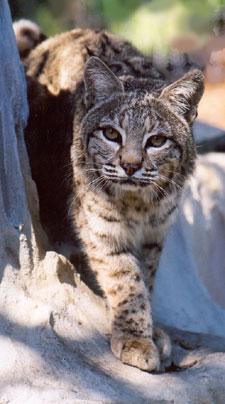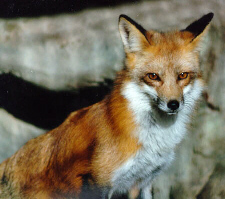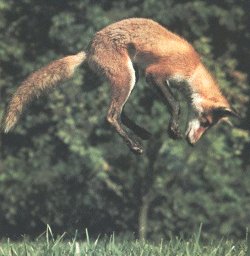
|
Though it's a fierce fighter, a bobcat isn't a large animal. A mature bobcat averages 36 inches in length, including a stubby, six-inch tail. This bobbed tail gives the bobcat its name. Pennsylvania bobcats weigh 15-20 pounds, with large individuals as heavy as 35 pounds.
The bobcats in our state have gray-brown fur with dark spots and bars, which are especially noticeable on the legs. Lips, chin, the underside of the neck and the belly are white. A ruff of fur extends out and downward from the ears. The bobcat's rangy, muscular back legs are longer than its front legs. This gives the animal a high-tailed, bobbing gait when it runs. The bobcat is a strong swimmer although it usually jumps creeks or fords them on fallen logs and is an excellent climber.
Bobcats are mainly nocturnal, but they sometimes venture out in the daytime. They have large eyes, well-adapted to see in the dark; bobcat pupils are slit-shaped rather than round and can open wide to admit light. Two other eye adaptations that help night vision are abundant light-sensitive rods and a reflecting layer that
makes an object stand out sharply from its background. Bobcats are colorblind and see only in shades of gray.
Small animals such as mice, wood rats, shrews, squirrels, chipmunks, birds, rabbits and hares form the nucleus of the bobcat's diet. But like most other predators, cats are opportunists, and porcupine, mink, muskrat, skunk, fish, frog, insect and fox remains have also been found in their stomachs. 
With a handsome red coat, black ears and legs, and white throat, belly and tail-tip. Length: 3-3½ feet including a bushy l6-inch tail. The female is slightly smaller than the male. Favorite habitat is rolling farmland interspersed with woods. The red fox is highly prized for their beautiful fur. 
Because of its well-developed sense of hearing, sight, and smell the red fox is an efficient and lethal predator; being an omnivore it eats whatever is available including corn, berries, apples, grasses, birds and mammals. The fox has many enemies including coyote, bobcat, and humans.
Red foxes have a characteristic manner of hunting mice as seen in the picture on the right. The fox stands motionless, listening and watching intently for a mouse it has detected. It then leaps high and brings the forelimbs straight down forcibly to pin the mouse to the ground. Pocono Wildlife Page 3 |
